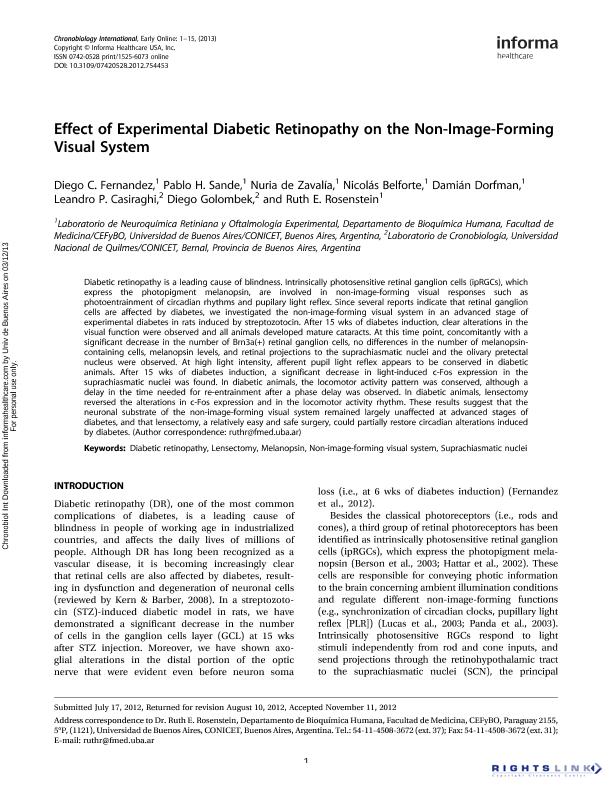Artículo
Effect of experimental diabetic retinopathy on the non-image-forming visual system
Fernandez, Diego Carlos ; Sande, Pablo Horacio; de Zavalia, Nuria Maria Asuncion
; Sande, Pablo Horacio; de Zavalia, Nuria Maria Asuncion ; Belforte, Nicolás Adalberto
; Belforte, Nicolás Adalberto ; Dorfman, Damián
; Dorfman, Damián ; Casiraghi, Leandro Pablo
; Casiraghi, Leandro Pablo ; Golombek, Diego Andres
; Golombek, Diego Andres ; Rosenstein, Ruth Estela
; Rosenstein, Ruth Estela
 ; Sande, Pablo Horacio; de Zavalia, Nuria Maria Asuncion
; Sande, Pablo Horacio; de Zavalia, Nuria Maria Asuncion ; Belforte, Nicolás Adalberto
; Belforte, Nicolás Adalberto ; Dorfman, Damián
; Dorfman, Damián ; Casiraghi, Leandro Pablo
; Casiraghi, Leandro Pablo ; Golombek, Diego Andres
; Golombek, Diego Andres ; Rosenstein, Ruth Estela
; Rosenstein, Ruth Estela
Fecha de publicación:
05/2013
Editorial:
Taylor & Francis
Revista:
Chronobiology International
ISSN:
0742-0528
e-ISSN:
1525-6073
Idioma:
Inglés
Tipo de recurso:
Artículo publicado
Clasificación temática:
Resumen
Diabetic retinopathy is a leading cause of blindness. Intrinsically photosensitive retinal ganglion cells (ipRGCs), which express the photopigment melanopsin, are involved in non-image-forming visual responses such as photoentrainment of circadian rhythms and pupillary light reflex. Since several reports indicate that retinal ganglion cells are affected by diabetes, we investigated the non-image-forming visual system in an advanced stage of experimental diabetes in rats induced by streptozotocin. After 15 wks of diabetes induction, clear alterations in the visual function were observed and all animals developed mature cataracts. At this time point, concomitantly with a significant decrease in the number of Brn3a(+) retinal ganglion cells, no differences in the number of melanopsin-containing cells, melanopsin levels, and retinal projections to the suprachiasmatic nuclei and the olivary pretectal nucleus were observed. At high light intensity, afferent pupil light reflex appears to be conserved in diabetic animals. After 15 wks of diabetes induction, a significant decrease in light-induced c-Fos expression in the suprachiasmatic nuclei was found. In diabetic animals, the locomotor activity pattern was conserved, although a delay in the time needed for re-entrainment after a phase delay was observed. In diabetic animals, lensectomy reversed the alterations in c-Fos expression and in the locomotor activity rhythm. These results suggest that the neuronal substrate of the non-image-forming visual system remained largely unaffected at advanced stages of diabetes, and that lensectomy, a relatively easy and safe surgery, could partially restore circadian alterations induced by diabetes.
Archivos asociados
Licencia
Identificadores
Colecciones
Articulos(CEFYBO)
Articulos de CENTRO DE ESTUDIOS FARMACOLOGICOS Y BOTANICOS
Articulos de CENTRO DE ESTUDIOS FARMACOLOGICOS Y BOTANICOS
Articulos(SEDE CENTRAL)
Articulos de SEDE CENTRAL
Articulos de SEDE CENTRAL
Citación
Fernandez, Diego Carlos; Sande, Pablo Horacio; de Zavalia, Nuria Maria Asuncion; Belforte, Nicolás Adalberto; Dorfman, Damián; et al.; Effect of experimental diabetic retinopathy on the non-image-forming visual system; Taylor & Francis; Chronobiology International; 30; 4; 5-2013; 583-597
Compartir



